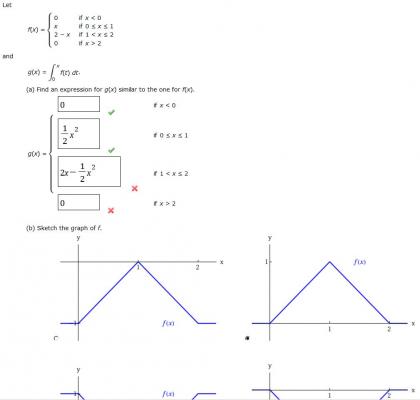

Mindrust
-
Posts
7 -
Joined
-
Last visited
Content Type
Profiles
Forums
Events
Posts posted by Mindrust
-
-
-
Thanks.
BTW, what does that big "pi" looking symbol mean?
0 -
Find the nth derivative of sqr(2x-1).
That means we need to find a pattern. Here's what I've got so far, from 1st derivative to 5th:
The pattern for the exponent is simple, 1/2 - n
The pattern for the co-efficient is what I'm stuck on. Here's what it looks like. I'm not sure how to express it mathematically.
1 -> 1 = 1
2 -> -1 = 1(-1)
3 -> 3 = 1(-1)(-3)
4 -> -15 = 1(-1)(-3)(-5)
5 -> 105 = 1(-1)(-3)(-5)(-7)
and so on...
Anyone know how to make a function for the coefficient in terms of n?
0 -
No. If the number is "close to zero" but not actually zero, then 1 over that number is not infinite. It may be very, very large. But it is NOT infinite.
You're right, what I meant to say was: as x approaches zero, 1/x = infinity.
0 -

How does one go about solving this algebraically? I tried creating a new variable (let a = log(base5)x) to get a^(1/2) + a^(1/3) = 2 but not sure what to do from there... If I can figure out how to get rid of the radicals, the rest should be simple.
[EDIT ] A friend helped me with the answer.
Let y = log_5(x)Let z = y^(1/6)
Then the given equation becomes z^3 + z^2 = 2, that is (z-1)(z+1+i)(z+1-i) = 0. The solutions are r = 1, s = -1-i, and t=-1+i.
Then x = 5^(r^6) =, 5^(s^6), 5^(t^6) are solutions of the original equation. The only real valued solution is x = 5.
Alternatively, you can arrange the equation into cubic form, and get the roots using the cubic formula.
0 -
The concept looked interesting at first, but several problems emerged after thinking about it.
First,
1/0 = undefined ; 1/(number close to zero) = infinity
That means there must be at least something, an infinitely small amount of energy, if you will.
The second problem is, even if we say 1/0 = infinity, then
(1/0) x 0 = infinity x 0
= 1 x 0 = infinity x 0
= infinity x 0 = 0
Why? Because 0/0 does not equal to 1 as you assume in your initial calculation. 0/0 = 0. One could even say it's undefined.
Third, if you want to get really technical, 0 does not equal nothing, in mathematics. There is another symbol to represent that.
0







Integration of Piecewise Functions?
in Analysis and Calculus
Posted
So for the third piece of g(x), I was missing the constant at the end, C.
To find C, I let the third equal the second, at x=1. So...
2x - 0.5x^2 + C = 0.5x^2 (at x=1)
Then solve for C, which is -1.
So the answer to the third is 2x - 0.5x^2 - 1
I know I have the right answer, but not sure if my method is correct. Can anyone confirm? Thanks!